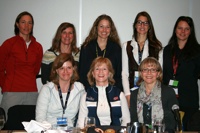 At 7:30 am on day two of the 2012 SIA Show (Friday, January 27), a ballroom-full of snow industry professionals gathered to hear a panel discussion on the ever-confounding women’s market. Titled Growing SnowSports Participation from a Woman’s Perspective and moderated by SIA’s Kellyann Davis, panelist included Burton President Donna Burton Carpenter as well Roxy’s Kyre Malkemes, Ski Utah’s Raelene Davis, Wachussett Mountain’s Carolyn Crowley Stimpson, Caldwell Sports’ Amy Caldwell, Freelance Writer Heather Schultz, and Outdoor Divas Kim Walker.
At 7:30 am on day two of the 2012 SIA Show (Friday, January 27), a ballroom-full of snow industry professionals gathered to hear a panel discussion on the ever-confounding women’s market. Titled Growing SnowSports Participation from a Woman’s Perspective and moderated by SIA’s Kellyann Davis, panelist included Burton President Donna Burton Carpenter as well Roxy’s Kyre Malkemes, Ski Utah’s Raelene Davis, Wachussett Mountain’s Carolyn Crowley Stimpson, Caldwell Sports’ Amy Caldwell, Freelance Writer Heather Schultz, and Outdoor Divas Kim Walker.
While much of what was discussed has been tossed around in similar panels and snowsports conference roundtables during the past twelve years, a few notable points did jump out. Most obviously, women have different shopping habits than men and with that comes a need for separate customer service training on the retail floor. “Women want to be included and educated about things that are specific to them personally,” says Malkemes. “They don’t necessarily want to know the technical benefits to each item, they just want to know how a product will make snowboarding more fun and more enjoyable for them.”
Follow the jump for the rest of the story.On the resort side of things, Wachussett Mt.’s Crowley Simpson pushed making the sport more affordable and easier. “Lower prices and cheap season pass offers have worked really well for us,” she says. Burton Carpenter echoed those sentiments but pushed resorts even further stressing the need for the mountains to be more flexible with lift tickets to accommodate those trying to ride while caring for young children.
However, according to Burton Carpenter getting more women involved in snowsports is really about understanding the individual life and career cycle of a typical female. SIA reports that of the 10.5 million people who consider themselves snowsports participants, 50-percent of them are women—many of whom have not skied or snowboarded in the last year. Burton Carpenter suggests while it important to grow the sport through new participants it is also essential to understand why and when the industry is loosing women in the sports. “We need to as an industry look at her life and figure out how to get her back,” she says. “It’s not just about those first lessons, but also maintaining and interacting with women at every stage of her life.”